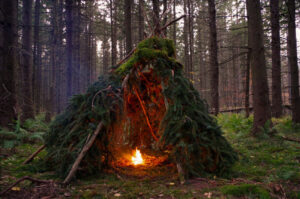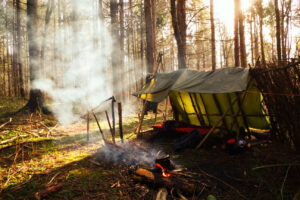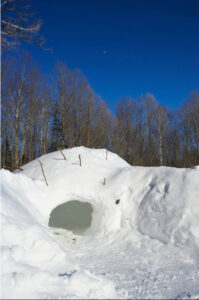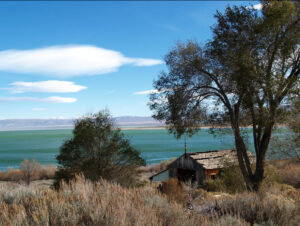Shelters are something many new preppers either ignore completely, assuming they’ll stay home during an emergency – or neglect because they feel as if they’ll just put a tent up if they ever have to endure a bug out situation.
But the reality is, sometimes you might not have access to a tent – or even a tarp. You might have to build a shelter out of whatever you find around you in the wilderness, with or without tools at your disposal
And in the event of a long-term survival event, it could be that you’ve had to evacuate your home and have to figure out how to build a homestead elsewhere. Would you know what to do if you were facing any of these scenarios?
Shelter Basics for Survival Needs
You never want to underestimate the comfort that you will receive from simply having shelter in a scary situation. While many preppers are focused on their food and water, you also need to make sure that you have something to keep you safe, dry, and warm.
There are some basic things you need to consider when it comes to your shelter planning. Ideally, you will have a product on hand such as a tent that you can quickly and easily put together in case you have to bug out.
For your home, you’ll have the security measures in place that are required to keep out any intruders who might be looking to harm you or take some of your survival supplies. But there are times when you have to leave your location and bug out elsewhere, which can make things more difficult.
Even if you have supplies on hand like a tent or a tarp, you still have to take into consideration different important decisions about your survival shelter efforts. Location is one of the most important issues.
The land that you build even a temporary shelter on has to be solid and free from the threat of any flood zones. You want to be hidden out of sight in a situation where necessary, or out in the open where rescue teams can find you in different situations.
If you are bugging out and need to build shelter, you want to be close enough to resources like a stream of running water, while keeping in mind that animals such as bears and other wildlife will also be near those sources, and you don’t want to put yourself in harm’s way.
It’s hard for you to build a shelter if you are out in the middle of a field of grass. But if you know where to go so that you can find branches, sticks, and other items to build a shelter with, this could help you based on the materials alone.
If you are purchasing products to use, such as a tent, you want to make sure that it is built to withstand certain temperatures and keep you safe from the elements. Some of the cheaply made products will not offer as much protection as others.

Short-Term Shelters You Can Build in an Instant
Tents are an obvious and easy option. When you are investing in a tent, you can look for ones that are perfect for one individual, or those that sleep 8-10 people. You want to get one that is right for the geographic location you are in and the time of year in terms of temperature.
You’ll be able to shop for tents that are perfect for cold weather or those that offer plenty of ventilation in hot weather climates. Make sure that it is durable and optimal for waterproofing and keeping insects out.
If you are going to be bugging out, that means you’ll probably be carrying the tent, so you’ll want one that is not too heavy and that can be set up quickly and easily by all of the members in your family.
If you don’t have the luxury of having a tent with you, you might be lucky enough to have a tarp. With a tarp, you may not have a floor as you would with a tent, but you can still have a waterproof shelter that protects you from rain or the sun.
In addition to the tarp itself, you also need some sort of paracord or rope that will allow you to secure it. You can usually find large rocks or logs to hold it down on the sides. If you have two tarps, you might be able to use one as the floor and the other as the overhead shelter.
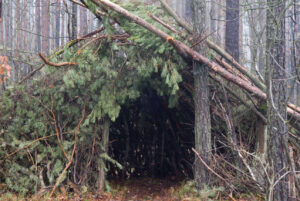
You have to have a mix of large and small sticks and completely cover the area with some sort of insulation such as leaves or other foliage. You’ll still need some type of paracord or rope to tie it all together, but if you have to use a sturdy vine, that might work in a pinch.
Some people who are unfamiliar with survival shelters, may feel as if they are without hope in a snowy situation. But you can even build a snow cave that can help keep you warm and out of harm’s way when it comes to the wind chill.
All you’ll need to do is dig yourself a snow tunnel of a few feet that allows you to keep the cold wind out. You can build a dome shaped covering to serve as the entrance and exit point of your structure.
There are many other short-term shelters you can learn how to make. These include huts made out of mud or debris, a cone-like Wikiup or Wigwam made with branches, mud, bark and leaves, or a treehouse that can keep you off the ground where some predators are hunting.
Shelters to Carry You Through Tough Times
You also need to know how to create shelters that will last a little bit longer than an overnight shelter that you may be building on your way from one location to the next. These can include temporary cabins that you build from materials that you chop down and fashion into a short-term home.
You might also want to build a shelter underground if there are threats that you want to evade during a survival situation where you prefer to go undetected. Or, you can build a larger temporary shelter such as a mud hut or Adobe home that protects you more than a lean-to quick set-up would.
This is perfect if you have found a bug out location that you know you’ll be stationary in until you are ready and able to build a permanent homestead. These options will provide more shelter than the other options that will likely fall apart or deteriorate, such as leaves that break down and decompose.
Developing a Homestead Property for Shelter and Long-Term Survival
Ideally, you’re going to have a homestead in an out of the way location where you are not at risk of being invaded or put in the crosshairs of some sort of major, chaotic situation.
A homestead property can also have a log cabin built on it, but these often have more permanent structures that are built before a survival situation. Some preppers even invest in large storage containers that they can leave on a property and fashion into a homestead little by little.
When you’re shopping for a homestead property to build your shelter on, you want to make sure that you’re thinking ahead and realizing that you have to be able to grow your own fruits and vegetables there, as well as raising livestock in some circumstances.
In addition to watching videos on how to do this yourself online, or reading books on the subject, you can also volunteer with local groups that allow you to learn how to build homes, so that you can take that insight and apply it to your own homestead property.
Now it is time to check out Post 10 in our series on Survival Prepping 101 – Why You Need to Invest in Communication Gear
Missed Part 8? No problem – you can check it out here – Why You Need To Get Your Finances in Order
